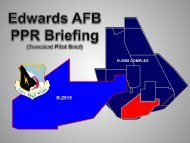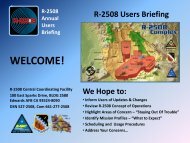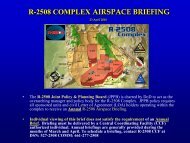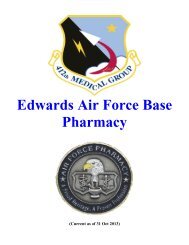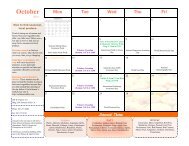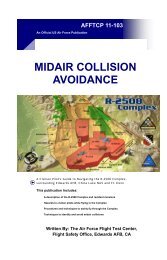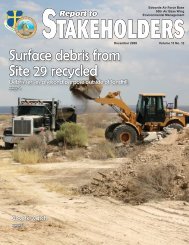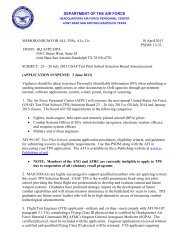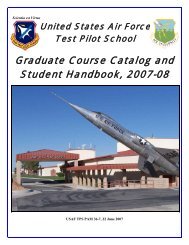AF Plant 42 AICUZ Study - Feb. 2012 - Edwards Air Force Base
AF Plant 42 AICUZ Study - Feb. 2012 - Edwards Air Force Base
AF Plant 42 AICUZ Study - Feb. 2012 - Edwards Air Force Base
Create successful ePaper yourself
Turn your PDF publications into a flip-book with our unique Google optimized e-Paper software.
tower at <strong>Plant</strong> <strong>42</strong>. This airspace extends outward from the center of<br />
the airfield 4.3 nm and upward from the surface to 5,000 above MSL<br />
(approximately 2,500 feet above ground level [AGL]). The term<br />
controlled airspace refers to airspace within which aircraft separation<br />
(i.e., ATC) is provided by the FAA or <strong>Air</strong> <strong>Force</strong> controllers.<br />
Separation of aircraft is achieved through a combination of a terminal<br />
radar approach control (TRACON) facility at <strong>Edwards</strong> <strong>AF</strong>B operated<br />
by the FAA and a control tower at <strong>Plant</strong> <strong>42</strong> also operated by the FAA.<br />
Access to this airspace requires establishing two-way communication<br />
prior to entry. The communication requirement allows ATC to<br />
provide in-flight separation service to aircraft operating instrument<br />
flight rules (IFR), permitting operations to occur during periods of<br />
less favorable weather as well as runway separation service (clearance<br />
to land or take off) to aircraft operating under Visual Flight Rules<br />
(VFR) during periods of good weather. Other controlled airspace in<br />
the area includes Class D areas of similar size and shape associated<br />
with the control towers at General William Fox airport and <strong>Edwards</strong><br />
<strong>AF</strong>B. Outside those areas, the airspace generally overlying the region<br />
that is either 700 or 1,200 feet AGL to 17,999 feet above MSL lies<br />
within Class E airspace. No specific communication requirement<br />
exists for traffic operating under VFR in Class E airspace; however,<br />
during periods of less favorable weather, operations must be<br />
conducted under IFR with specific clearance, communications,<br />
equippage, and plot certification requirements prior to entry.<br />
Apart from airspace designated for purposes of providing air traffic<br />
control services, the FAA designates special use airspace to segregate<br />
activities that may be hazardous (Restricted [R-] Areas) or have<br />
unusual levels or types of flight maneuvers (Military Operations<br />
Areas [MOA]). The nearest special use airspace to <strong>Plant</strong> <strong>42</strong> are the<br />
Restricted Areas and MOAs associated with <strong>Edwards</strong> <strong>AF</strong>B.<br />
The FAA classifies airspace<br />
based on whether it provides<br />
ATC. Separation services are<br />
provided to aircraft operating<br />
under Instrument Flight Rules.<br />
Controlled <strong>Air</strong>space (further<br />
subdivided into Class A, B, C,<br />
D or E) is airspace within<br />
which ATC separation service<br />
is provided; Class G is<br />
uncontrolled airspace; no ATC<br />
separation is provided. The<br />
airspace around <strong>Plant</strong> <strong>42</strong> is a<br />
mix of Class D, E, and G<br />
airspace. Of these three types,<br />
Class D is the most restrictive,<br />
requiring all aircraft to<br />
establish two-way<br />
communications prior to entry.<br />
In addition to controlling local<br />
traffic in the immediate<br />
vicinity of the airfield with <strong>Air</strong><br />
Traffic Control Towers at<br />
<strong>Plant</strong> <strong>42</strong>, General William Fox<br />
airport, and <strong>Edwards</strong> <strong>AF</strong>B, air<br />
traffic services are provided<br />
while in the region and en<br />
route. Within the<br />
Palmdale/<strong>Edwards</strong> <strong>AF</strong>B<br />
region, air traffic control<br />
service is provided by the High<br />
Desert Terminal Radar<br />
Approach Control, located on<br />
<strong>Edwards</strong> <strong>AF</strong>B. For aircraft<br />
transiting the area at higher<br />
altitudes, such as scheduled air<br />
carrier traffic going between<br />
Los Angeles and Atlanta, air<br />
traffic control service is<br />
provided by one of the<br />
approximately 20 <strong>Air</strong> Route<br />
Traffic Control Centers<br />
(ARTCC). The area of<br />
jurisdiction of an ARTCC is<br />
quite large; for example,<br />
aircraft operating at high<br />
altitudes over the west coast<br />
states of California, Oregon<br />
and Washington would be<br />
controlled by Los Angeles<br />
Center, Oakland Center, or<br />
Seattle Center. The ARTCC<br />
for the southern half of<br />
Calfiornia and parts of<br />
Arizona, Nevada, and Utah<br />
(LA Center) is in fact in<br />
Palmdale near main entrance<br />
to <strong>Plant</strong> <strong>42</strong>.<br />
2-6



